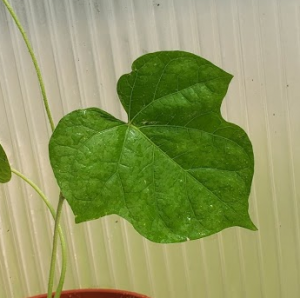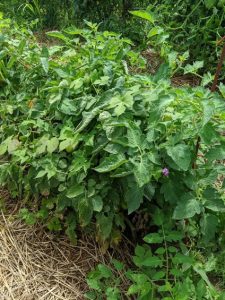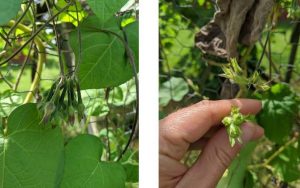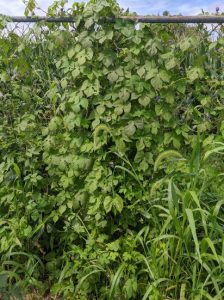Genus: Ipomoea sp.
Species:
- Ivyleaf: Ipomoea hederacea
- Entireleaf: Ipomoea hederacea integriuscula
- Tall: Ipomoea purpurea
- Pitted: Ipomoea lacunosa
Morning glories are among the most troublesome weeds in many cropping systems in the Midwest. They are difficult to control due to their fast growth, large seed size, and impenetrable seed coat.
Morning glories get their name because their flowers bloom in the morning and close up later in the day.
Identification: Cotyledons are hairless and butterfly-shaped (notched at the tips, forming two lobes that join at the base). Lobes are broad (Figure 1) except for pitted morning glory, which has a pointed tip. Mature plants have alternate leaves, which are commonly heart-shaped (tall, entire leaf, and pitted morning glories) (Figure 2) or 3-lobed, ivy-shaped (ivy leaf morning glory) (Figure 3). Leaves, petioles, and stems are densely haired (Figure 1), except for pitted morning glory, which is hairless.
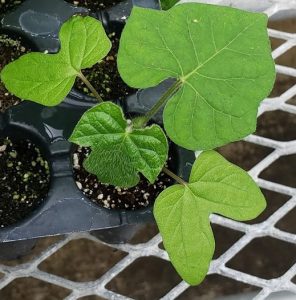
Figure 1. Ivyleaf morning glory seedling. Note the dense hairs on the true leaves. Photo by Jeanine Arana.
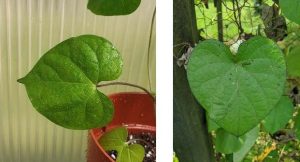
Figure 2. Heart-shaped leaves of entire leaf (left) and tall morning glory (right). Photo on the left by Jeanine Arana, photo on the right by Steve Meyers.
Growth habit: A summer annual, twining or climbing vine reaching 10 feet in length. Vining stems form branches that twine around other plants, making them difficult to detect and remove (Figure 4).
Reproduction: Flower petals are purple to pale blue or white and fused into a funnel (Figure 5). Flowers bloom from July to November. Reproduction is by seeds from 4 to 6 mm long (Figure 6), which form in capsules (Figure 7). Unlike many other annuals, they can germinate from much deeper in the soil at a depth of four inches or more (Figure 8).
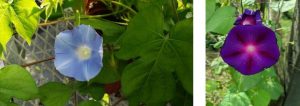
Figure 5. A pale blue ivy leaf morning glory flower (left) and a deep purple tall morning glory flower (right). Photos by Jeannie Arana and Steve Meyers.
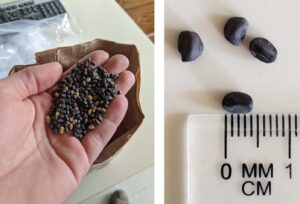
Figure 6. Morning glory seeds are black, relatively large, and wedge-shaped. Seed size 4mm. Left photo by Steve Meyers, right by Jeanine Arana.
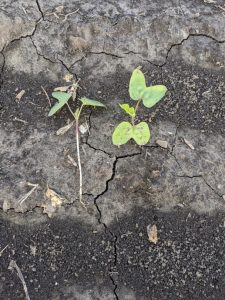
Figure 8. Morning glories are capable of germinating from greater depths than many other weeds. The white hypocotyl of the seedling on the left of this image suggests it germinated from approximately three inches deep. Photo by Steve Meyers.
Integrated weed management strategies
Cultural and mechanical practices:
- Scouting: Routine scouting before planting, during crop growth, and after harvest will help identify weeds early in the season, discover patches before they spread, and plan future control strategies.
- Exclusion: Manage morning glories in fence rows and field edges (Figure 9) to help reduce future weed pressure. For producers who grow sweet potatoes (a member of the morning glory family), controlling morning glories can also reduce disease pressure.
- Plastic mulch: Plastic mulch provides a physical barrier, preventing germinating morning glory seedlings from reaching the soil surface. Assure planting holes are big enough to fit only your transplant. Excessively large planting holes allow weeds to emerge right next to the crop.
- Stale Seedbed: Consider a stale seedbed treatment. In the case of morning glories, this practice may be most effective while preparing fields for fall crops. Prepare the site, allow weeds to germinate, and then control small, emerged weeds with either a broad-spectrum postemergence herbicide or shallow cultivation. This process can be repeated to encourage and control additional flushes of weeds prior to planting.
- Hand-weeding, hoeing, and cultivation: Remove seedlings before they reach five inches. After that, they are more difficult to control because they can twine onto the crop.
Chemical control:
- An effective herbicide-based weed management program relies on multiple applications to achieve season-long control. Consider combining a pre-plant burndown application with pre-planting and/or early season pre-emergence herbicides, followed by postemergence herbicides and delayed preemergence products (layby). Labeled herbicides available vary depending on many factors, including the crop being grown, the cropping system, crop growth stage, soil texture and organic matter, and weather conditions.
Check label restrictions for different crops in the Midwest Vegetable Production Guide for Commercial Growers 2024, available at https://www.mwveguide.org/guide. Always read and follow label instructions and remember to rotate modes of action to limit herbicide resistance.
